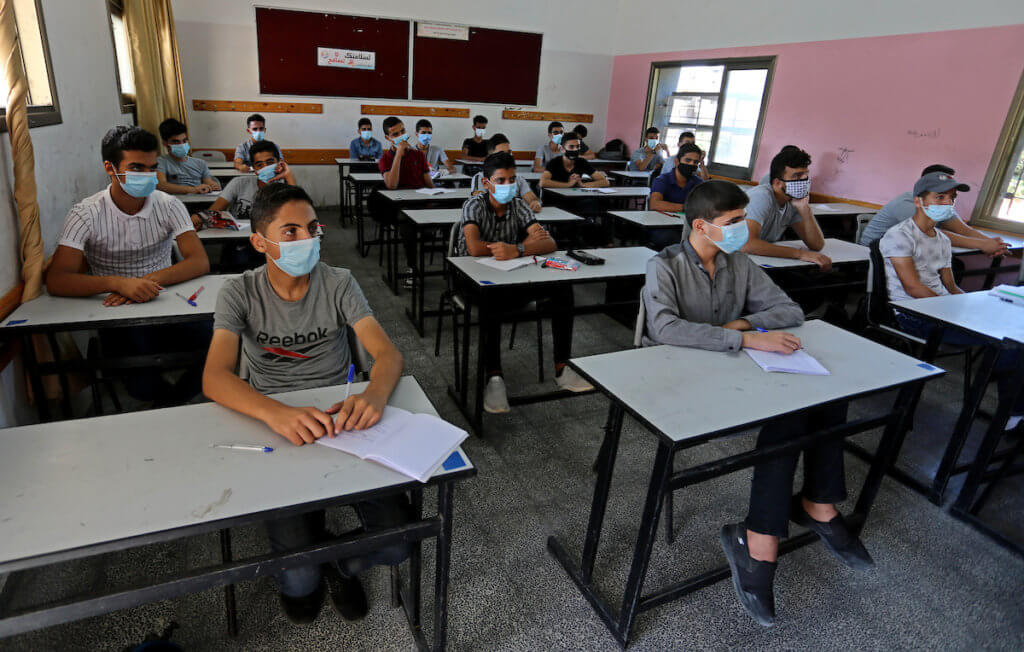The Latest:
- 54,853 Palestinians tested positive for COVID-19; 431 died
- Of those with COVID-19, 39,825 are from the West Bank; 3,839 are in Gaza, and 11,189 are in East Jerusalem
- 286,646 Israelis tested positive for COVID-19; 1,879 died
Recoveries are increasing
Last week when we brought you this newsletter we reported that new COVID-19 cases during September had shot up 40% in the West Bank and 85% in Gaza, with an average of 686 new cases per day across the month. This week it appears that October’s numbers are tracking at a slower rate of infection. New cases are averaging only 476 per day, according to the World Bank in its latest situation report.
The improvement began in the last week of September. On Monday, the UN reported 11,000 people recovered from COVID-19 between September 22 and the start of October. That dropped the number of active cases by 40%. As of Thursday, there are about 3,000 less active cases in the West Bank, East Jerusalem and Gaza Strip than there were in late September. If we look at the total number of cases since mid-March until now, around 85% have recovered.
But the curve isn’t dropping everywhere. There were at least 3,814 new cases in the last week. Most of the cases are in Hebron, East Jerusalem and Gaza. Incidentally, Gaza is where most of the new cases are located, adding up to around 18% of overall current Palestinian cases.
In East Jerusalem, another hotspot, the hospitals are about to fill up. St. Joseph’s is at 95% bed capacity. Al Makassed hospital is at 70% capacity. A total of 47 Palestinian patients are being treated in the ICU, of whom 11 are on oxygen ventilators, according to the Ministry of Health. Plans are in the works for increasing hospital beds in Jerusalem. We’ll keep you updated on that in this newsletter.
Saeb Erekat confirms he has COVID-19

Yesterday Palestinian negotiator and head of the PLO Saeb Erekat, 65, announced over Twitter that he tested positive for COVID-19. His condition is not yet known.
Erekat, the first senior Palestinian official to contract the respiratory disease, posted in English and Arabic late Thursday evening:
The Secretariat of the PLO Executive Committee and the NAD announce that Dr.Saeb Erekat, the PLO SG and the Head of the Negotiations Dept, has been infected with COVID-19, and wishes him a speedy recovery. We apologize for canceling all his appointments until his complete recovery.
Erekat has led the PLO’s negotiations affairs department since 1995 and was an diplomat during the Oslo Accords. In 2017 he received a lung transplant in the U.S. in Virginia after battling pulmonary fibrosis, or scaring in the lung tissue that makes breathing and absorbing oxygen difficult.
Lockdowns, lulls, and long-term plans
On of the trickiest parts about containing the coronavirus in Israel and the occupied Palestinian territory is that effectively there are four different regions with four different policies, and even then there is a lot of daylight in how policies are enforced. Israel has been under a second full-scale lockdown since mid-September that is due to continue until October 14. This includes East Jerusalem.
Similarly the West Bank has been under a second state of emergency and on October 2 the Palestinian Authority announced it will continue through the end of the month. However, schools did reopen at the start of September. While some were shut down in the first week or opted for virtual learning, many remain open.
Gaza is now about six weeks into lockdown, but imposes mixed levels of restrictions depending on the rate of infection. Around a dozen areas have stricter limitations on movement, but in the last week authorities eased a number of limitations on movement. Palestinians can now travel between different governorates and outdoor fruit and vegetable markets are allowed to once again operate. This coming Sunday—the start of the weekday in Gaza—twelfth-grade students will head back to schools.
Only 4% of Gaza’s factories remain open

The Gaza based human rights group Al Mezan reported this week the pandemic and subsequent lockdown has taken a toll on Palestinian workers in Gaza. We’ve covered the economic contraction in this newsletter before, but we’ve mostly focused on the declining GDP, which is an important indicator, but doesn’t reveal much about the conditions of working families. What Al Mezan analyzed is data gathered in April 2020 on the newly unemployed.
Al Mezan writes, “Only 87 factories remain operational compared to 2,065 prior to the pandemic. Accordingly, the number of their workers dropped from 21,790 to 3,690 workers, leaving 18,100 individuals jobless.”
In other words, only 17% of Gaza’s industrial workforce is still employed. A majority of those who are working, work in textile producing factories, which was the largest industrial sector before the pandemic.
Of those who lost their jobs, the largest group, or 39% live in Gaza City.
Bear in mind, prior to the pandemic, according to 2019 census data, industrial workers were most likely not earning a minimum wage. Around 80% of all Palestinian employees in Gaza’s private sector earn less than 1,450 NIS per month (the minimum wage). The median monthly wage in the private sector was just 660 NIS.


